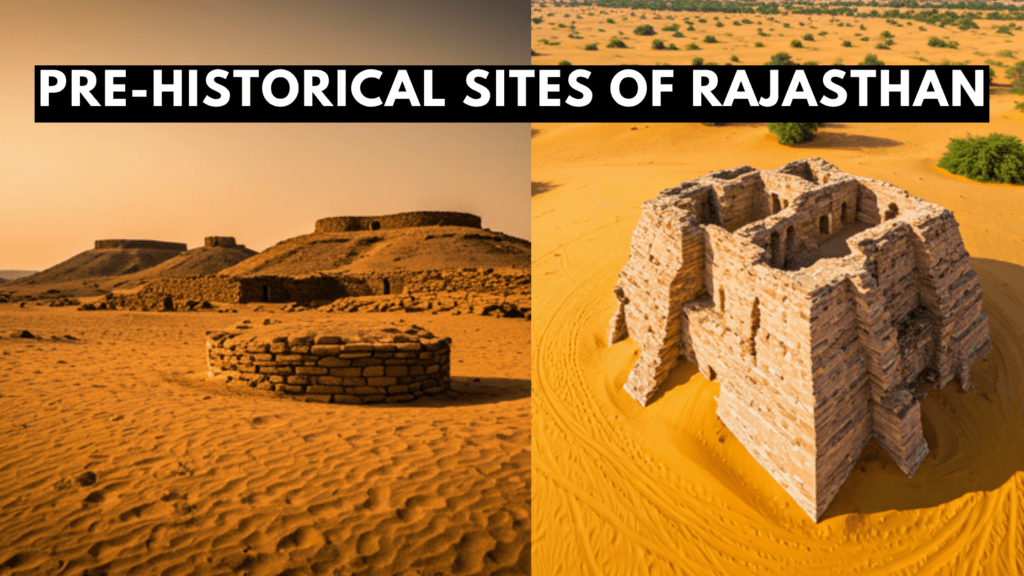Pre-Historical Sites of Rajasthan: From Palaeolithic to Chalcolithic and Bronze Age. Rajasthan, an Indian state rich in history, holds a significant place in the study of prehistoric India. Various archaeological excavations across the Rajasthan state have revealed evidence of human habitation dating back to the Palaeolithic, Mesolithic, Chalcolithic, and Bronze Ages. These discoveries offer insights into the early human civilizations that flourished in Rajasthan.
This comprehensive set of notes on Pre-historical sites of Rajasthan is essential for students preparing for competitive exams like RPSC RAS Prelims and Mains.
Also, check: Geography of Rajasthan For RPSC RAS Prelims
Pre-historical sites of Rajasthan

- Palaeolithic Age in Rajasthan (Old Stone Age)
- Mesolithic Age in Rajasthan (Middle Stone Age)
- Chalcolithic Age in Rajasthan (Copper Age)
- Bronze Age in Rajasthan (Harappan Civilization)
- Cultural Significance
The prehistoric sites of Rajasthan: from the Palaeolithic to the Chalcolithic and Bronze Ages offer invaluable insights into early human evolution, adaptation, and civilization. These sites form the bedrock of Rajasthan’s ancient history and underscore its role in the broader narrative of India’s archaeological heritage.
Also, check: RPSC RAS Prelims Exam 2024 | General Knowledge and General Science
1. Palaeolithic Age in Rajasthan (Old Stone Age)
The Palaeolithic Age in Rajasthan is marked by the presence of ancient stone tools and evidence of early human settlement.
- Key Features:
- Early humans during this period were hunter-gatherers and used primitive stone tools for hunting and daily activities.
- Tools discovered include hand-axes, cleavers, and flakes made from quartzite.
- Major Sites:
- Didwana (Nagaur District): Archaeological excavations have revealed tools from the Lower Palaeolithic period.
- Budha Pushkar (Ajmer District): Tools from the Middle and Upper Palaeolithic periods have been found here.
2. Mesolithic Age in Rajasthan (Middle Stone Age)
The Mesolithic Age in Rajasthan marked a transition from hunting to food gathering and the development of more refined tools.
- Key Features:
- The tools were smaller and sharper, known as microliths. These were used for various purposes, including hunting small animals and fishing.
- Rock paintings found in certain parts of Rajasthan provide evidence of human life and activities during this period.
- Major Sites:
- Bagor (Bhilwara District): One of the largest Mesolithic sites in India, Bagor contains evidence of microliths, animal bones, and human burials.
- Tilwara (Barmer District): Excavations have revealed tools, animal remains, and evidence of human settlement.
Also, check: Geography of Rajasthan For RPSC RAS Prelims
3. Chalcolithic Age in Rajasthan (Copper Age)
The Chalcolithic Age (3300–1200 BCE) marks the beginning of metal use, with humans transitioning from stone to copper tools.
- Key Features:
- Chalcolithic people used a combination of stone and copper tools, primarily for agricultural purposes.
- Settlements during this period were often located near rivers and water bodies, which facilitated farming and irrigation.
- Major Sites:
- Ahar (Udaipur District): Also known as the Ahar-Banas culture, this site is a major Chalcolithic settlement. Excavations have revealed copper tools, pottery, and evidence of agricultural activities.
- Balathal (Udaipur District): Another important site, Balathal has provided evidence of well-planned settlements with mud-brick houses and copper artifacts.
4. Bronze Age in Rajasthan (Harappan Civilization)
The Bronze Age in Rajasthan is closely linked to the Indus Valley Civilization. While Rajasthan is not at the core of the Indus Valley sites, it has important peripheral settlements that contribute to our understanding of this ancient civilization.
- Key Features:
- The use of bronze tools and advanced urban planning are the hallmarks of this age.
- Pottery, seals, and other artifacts provide evidence of trade and cultural exchange with the larger Indus Valley network.
- Major Sites:
- Kalibangan (Hanumangarh District): A prominent Harappan site, Kalibangan has revealed evidence of pre-Harappan and Harappan settlements, including mud-brick houses, fire altars, and plowed agricultural fields.
- Sothi (Bikaner District): Considered a pre-Harappan site, Sothi is important for understanding the early phases of the Harappan civilization. Pottery and other artifacts from this site resemble those found in the Indus Valley.
5. Cultural Significance
These pre-historical sites highlight Rajasthan’s role in the early development of human civilization. The transition from stone to metal tools, the shift from hunting-gathering to agriculture, and the establishment of settled communities laid the foundation for the later historical periods.
- Impact on Rajasthan’s Later Cultures:
- The Ahar-Banas culture influenced the region’s later developments, including its architecture, pottery, and agricultural practices.
- Kalibangan provides crucial links between the Harappan civilization and the development of urban settlements in Rajasthan.
Conservation of Pre-Historic Sites
Many of these sites are now under archaeological protection (ASI), but urbanization and climate change continue to pose threats. Conservation efforts are critical for preserving Rajasthan’s rich prehistoric heritage.
Read more: Rajasthan General Studies | General Knowledge of Rajasthan
